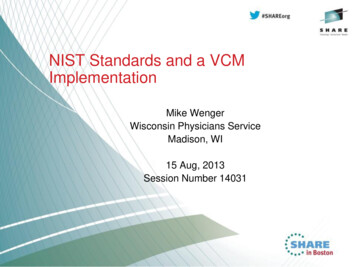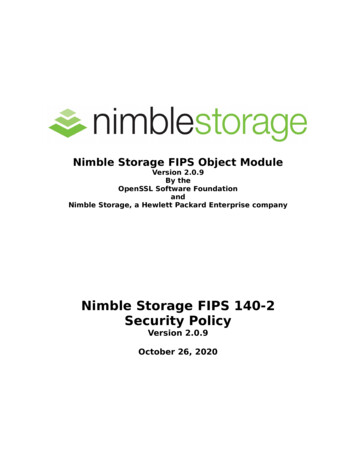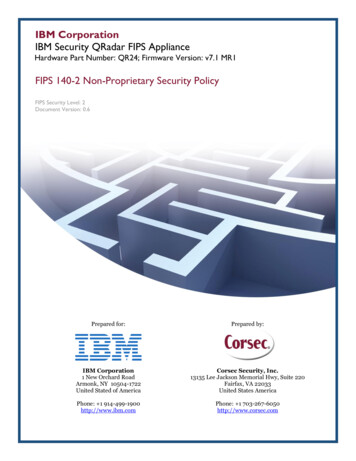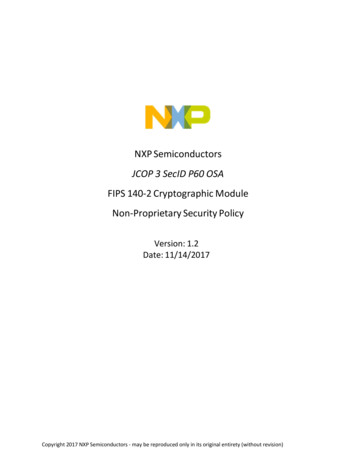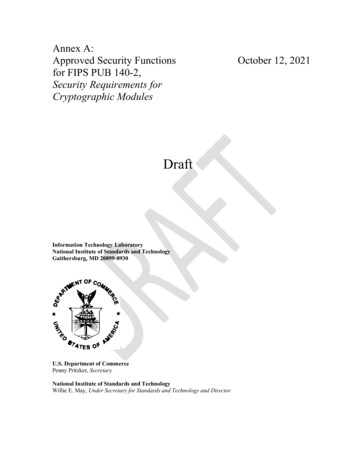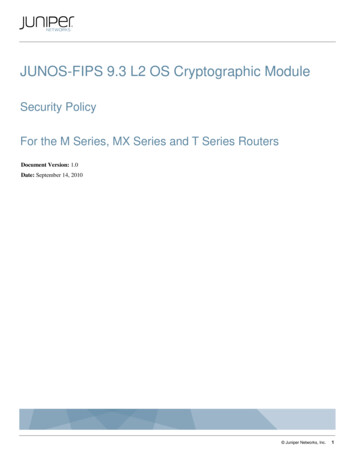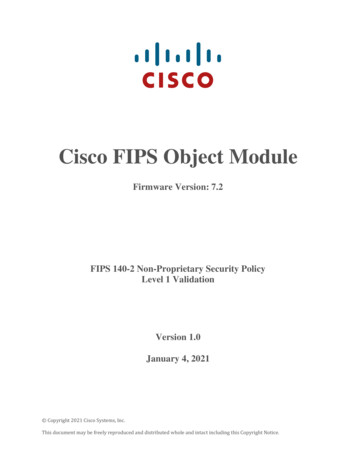
Transcription
Cisco FIPS Object ModuleFirmware Version: 7.2FIPS 140-2 Non-Proprietary Security PolicyLevel 1 ValidationVersion 1.0January 4, 2021 Copyright 2021 Cisco Systems, Inc.This document may be freely reproduced and distributed whole and intact including this Copyright Notice.
Table of Contents1INTRODUCTION . 11.11.21.31.41.52PURPOSE . 1MODULE VALIDATION LEVEL . 1REFERENCES . 2TERMINOLOGY . 2DOCUMENT ORGANIZATION. 2CISCO FIPS OBJECT MODULE . 32.1 MODULE INTERFACES . 42.2 ROLES AND SERVICES . 62.2.1 Crypto-Officer Role . 62.2.2 User Role . 62.3 PHYSICAL SECURITY . 72.4 CRYPTOGRAPHIC ALGORITHMS . 82.4.1 Approved Cryptographic Algorithms . 82.4.2 Non-FIPS Approved Algorithms Allowed in FIPS mode . 92.5 CRYPTOGRAPHIC KEY MANAGEMENT . 92.5.1 Key Generation . 102.5.2 Key Storage . 102.5.3 Key Access . 102.5.4 Key Protection and Zeroization. 102.6 SELF-TESTS . 123SECURE DISTRIBUTION, OPERATION, AND USER GUIDANCE . 143.1 SECURE DISTRIBUTION . 143.2 SECURE INITIALIZATION . 143.3 SECURE OPERATION . 143.4 USER GUIDANCE . 153.4.1 Triple-DES Keys . 153.4.2 AES GCM IV Generation . 15APPENDIX A – ACRONYMS AND ABBREVIATIONS . 16 Copyright 2021 Cisco Systems, Inc.iThis document may be freely reproduced and distributed whole and intact including this Copyright Notice.
11.1IntroductionPurposeThis document is the non-proprietary Cryptographic Module Security Policy for the Cisco FIPS Object Module (FOM).This security policy describes how the FOM (Firmware Version: 7.2) meets the security requirements of FIPS 140-2,and how to operate it in a secure FIPS 140-2 mode. This policy was prepared as part of the Level 1 FIPS 140-2validation of the Cisco FIPS Object Module.FIPS 140-2 (Federal Information Processing Standards Publication 140-2 — Security Requirements for CryptographicModules) details the U.S. Government requirements for cryptographic Modules. More information about the dex.html.1.2 Module Validation LevelThe following table lists the level of validation for each area in the FIPS PUB 140-2.Table 1 - Module Validation LevelNo.Area TitleLevel1Cryptographic Module Specification12Cryptographic Module Ports and Interfaces13Roles, Services, and Authentication14Finite State Model15Physical Security16Operational Environment7Cryptographic Key management18Electromagnetic Interface/Electromagnetic Compatibility19Self-Tests110Design Assurance311Mitigation of Other AttacksN/AN/AOverall Module validation level Copyright 2021 Cisco Systems, Inc.11This document may be freely reproduced and distributed whole and intact including this Copyright Notice.
1.3ReferencesThis document deals only with operations and capabilities of the Cisco FIPS Object Module in the technical terms ofa FIPS 140-2 cryptographic Module security policy. More information is available from the following sources:For answers to technical or sales related questions please refer to the contacts listed on the Cisco Systems websiteat www.cisco.com.The NIST Validated Modules website tml) contains contactinformation for answers to technical or sales-related questions for the module.1.4 TerminologyIn this document, the Cisco FIPS Object Module (FOM) is referred to as FOM, the cryptographic module or themodule.1.5 Document OrganizationThe Security Policy document is part of the FIPS 140-2 Submission Package. In addition to this document, theSubmission Package contains: Vendor Evidence documentFinite State MachineOther supporting documentation as additional referencesThis document provides an overview of the Cisco FIPS Object Module and explains the secure configuration andoperation of the module. This introduction section is followed by Section 2, which details the general features andfunctionality of the module. Section 3 specifically addresses the required configuration for the FIPS-mode ofoperation.With the exception of this Non-Proprietary Security Policy, the FIPS 140-2 Validation Submission Documentation isCisco-proprietary and is releasable only under appropriate non-disclosure agreements. For access to thesedocuments, please contact Cisco Systems.2 Copyright 2021 Cisco Systems, Inc.This document may be freely reproduced and distributed whole and intact including this Copyright Notice.
2 Cisco FIPS Object ModuleThe Cisco FIPS Object Module (FOM) is a firmware library that provides cryptographic services to a vast array ofCisco's networking and collaboration products. The Cisco product lines that include FOM to provide FIPS 140-2validated cryptographic functionalities are as below:Cisco Catalyst IoT, LAN and Enterprise Switches including Wireless Controllers and Access PointsCisco WAN Aggregation and Internet Edge RoutersCisco Nexus Data Center SwitchesCisco SD-WAN Viptela SolutionsCisco FirewallsCisco Telepresence and Communication SystemsThe cryptographic module provides primitives of secure protocols such as IKEv2/IPSec, sRTP, SSH, TLS, and SNMPv3.It does not implement any of these security protocols, instead it provides the cipher operation and Key DerivativeFunction (KDF) functionalities for the services.The module is based on the OpenSSL FIPS canister with additions to support Suite B algorithms. For the purposes ofFIPS 140-2 level 1 validation, the FOM is a single object module file named fipscanister.o (Linux / FreeBSD Android)or fipscanister.lib (Microsoft Windows). The object code in the object module file is incorporated into the runtimeexecutable application at the time the binary executable is generated. The module performs no communicationsother than with the consuming application (the process that invokes the module services via the module’s API),which can be considered as the host for the module.The module’s logical block diagram is shown in Figure 1 below.Physical BoundaryConsuming ApplicationAPIFIPS ObjectModule (FOM)Crypto AlgorithmsOperating SystemLegendPhysical boundaryLogical boundaryFigure 1 – Cisco FIPS Object Module Block Diagram Depicting Cryptographic Boundary3 Copyright 2021 Cisco Systems, Inc.This document may be freely reproduced and distributed whole and intact including this Copyright Notice.
The dashed red border denotes the logical cryptographic boundary of the module. The physical cryptographicboundary of the module is the enclosure of the system on which it is executing and is denoted by the dashed blueborder.This module was tested on the following platforms for the purposes of this FIPS 140-2 validation:Table 2 - Tested Operational Environments (OEs)#PlatformProcessorOperating SystemsACVP Certificate1Evaluation boardCavium Octeon CN5230Linux 2.6A1102Cisco Catalyst 9300Intel Xeon D-1526 (with AES-NI)Linux 4.4A1143Cisco Catalyst 9200ARM 8 Cortex-A53 AArch64Linux 4.4A1094Cisco UCS M5Intel Xeon Gold 6128 (with AES-NI)Linux 4.18A1125Cisco ASA 5555Intel Xeon X3460Linux 4.1A1116Cisco Nexus 3172Intel Pentium B 925C (with AES-NI)Linux 4.1A1057Cisco ISR 4451Intel Xeon E3-1105C (with AES-NI)Linux 4.4A1068Cisco Firepower 9300Intel Xeon E5-2658 (with AES-NI)Linux 4.1A1139Cisco ISR 4351Intel Atom C2758 (with AES-NI)Linux 4.4A1082.1 Module InterfacesThe physical ports of the module are the same as the system on which it is executing. The logical interface is a Clanguage application program interface (API).The Data Input interface consists of the input parameters of the API functions. The Data Output interface consists ofthe output parameters of the API functions. The Control Input interface consists of the actual API functions. TheStatus Output interface includes the return values of the API functions.The module provides a number of physical and logical interfaces to the application (and the device upon which it isrunning), and the physical interfaces provided by the module are mapped to the following FIPS 140-2 defined logicalinterfaces: data input, data output, control input, and status output. The logical interfaces and their mapping aredescribed in the following table:4 Copyright 2021 Cisco Systems, Inc.This document may be freely reproduced and distributed whole and intact including this Copyright Notice.
Table 3 - FIPS 140-2 Logical InterfacesInterfaceDescriptionData InputAPI input parameters - plaintext and/or ciphertext dataData OutputAPI output parameters - plaintext and/or ciphertext dataControl InputAPI function calls - function calls, or input arguments that specify commands and control data usedto control the operation of the moduleStatus OutputAPI return codes- function return codes, error codes, or output arguments that receive statusinformation used to indicate the status of the modulePowerNot Applicable5 Copyright 2021 Cisco Systems, Inc.This document may be freely reproduced and distributed whole and intact including this Copyright Notice.
2.2 Roles and ServicesThe module meets all FIPS 140-2 level 1 requirements for Roles and Services, implementing both User and CryptoOfficer roles. The module does not authenticate the roles. Only one role may be active at a time.2.2.1 Crypto-Officer RoleCrypto-Officer (CO) role is responsible for installing the module on the host computer system. The CO role is implicitlyentered during installation process or performing system administration functions on the host operating system.The following table lists the approved or non-approved but allowed services available in FIPS 140-2 approved mode.The services available to the CO role accessing the Critical Security Parameters (CSPs), the type of access – read (r),write (w), execute (e) and zeroized/delete (d) – and which role accesses the CSPs are listed below:Table 4 - Roles, Services, and Keys in FIPS 140-2 Approved Mode of OperationServiceCSPAccessModule InstallationNoneN/AShow statusNoneN/AModule initializationNoneN/APerform Self-testNoneN/AAll CSPsdUninstallation2.2.2 User RoleUser role has access to all of the cryptographic services provided by the module. The following table lists theapproved or non-approved but allowed services available in FIPS 140-2 approved mode. The services available tothe User role accessing the CSPs, the type of access – read (r), write (w), execute (e) and zeroized/delete (d) – andwhich role accesses the CSPs are listed below:6 Copyright 2021 Cisco Systems, Inc.This document may be freely reproduced and distributed whole and intact including this Copyright Notice.
Table 5 - User Role Services Available in FIPS Mode of OperationServiceCSPAccessSymmetric encryption/decryptionSymmetric Keysr, w, e, dSymmetric Legacy DecryptionSymmetric Legacy Keyr, w, e, dSymmetric DigestSymmetric Keysr, w, e, dAES Key Wrap (KW)Symmetric Keys (NIST SP 800-38F AES Key Wrapping using bothKW mode with 128/192/256-bit AES key)r, w, e, dAsymmetric Encryption andDecryptionAsymmetric KeysDigital signature generation andverificationAsymmetric KeysAsymmetric Key GenerationAsymmetric Keysr, w, e, dSymmetric Key GenerationSymmetric Keysr, w, e, dKey exchange componentDiffie-Hellman/EC Diffie-Hellman key componentsr, w, e, dKey establishment componentKey agreement scheme componentsr, w, e, dKey Derivation Function (KDF)KDF Keysr, w, e, dKeyed Hash (HMAC)Keyed Hash keyr, w, e, dMessage digest (SHS)None-Random number generationDRBG InputZeroizationAll CSPsr, w, e, dr, w, e, dr, w, e, dd2.3 Physical SecurityPer FIPS 140-2 classification, this is a multi-chip standalone cryptographic module. FOM 7.2 is a firmware onlymodule and runs on production grade chassis.7 Copyright 2021 Cisco Systems, Inc.This document may be freely reproduced and distributed whole and intact including this Copyright Notice.
2.4 Cryptographic AlgorithmsThe module supports the following FIPS 140-2 approved algorithm implementations:2.4.1 Approved Cryptographic AlgorithmsTable 6 - Approved Cryptographic AlgorithmsAlgorithmAESAlgorithm CapabilitiesKey sizes: 128, 192, 256 bitsModes: CBC, CCM, CFB1/8/128, CMAC,CTR, ECB, GCM, GMAC, KW, OFB, XTS1SP800-90A DRBGDSAAlgorithm Certificate NumbersHASH DRBG, HMAC DRBG, CTR DRBGA105, A106, A108, A109, A110, A111, A112,A113, A114Key sizes: 2048, 3072 bitsKeyGen, PQGGen, PQGVer, SigGen,SigVerECDSACurves: P-224, P-256, P-384, P-521,K-233, K-283, K-409, K-571,B-233, B-283, B-409, B-571KeyGen, KeyVer, SigGen, SigVerHMACCVL (SP800-56A)HMAC-SHA-1, HMAC-SHA2-224, HMACSHA2-256, HMAC-SHA2-384, HMACSHA2-512, HMAC-SHA2-512/224, HMACSHA2-512/256, HMAC-SHA3-224, HMACSHA3-256, HMAC-SHA3-384, HMACSHA3-512KAS-ECC CDH-Component:Curves: B-233, B-283, B-409, B-571,K-233, K-283, K-409, K-571, P-224, P256, P-384, P-521KAS-ECC Component:Curves: P-224, P-256, P-384, P521KAS-FFC Component:FB: SHA2-224, SHA2-256FC: SHA2-256CVL (SP800-135)2SNMPv3, sRTP, TLS, SSHv2, IKEv21AES-XTS: 128-bit and 256-bit onlyThere is no other part of protocols (IKEv2, TLS, SSH, sRTP and SNMPv3), except the KDF, have been reviewed ortested by the CAVP and CMVP. Please refer IG D.11, bullet 2 for more information.28 Copyright 2021 Cisco Systems, Inc.This document may be freely reproduced and distributed whole and intact including this Copyright Notice.
AlgorithmKBKDF (SP800-108)Algorithm CapabilitiesAlgorithm Certificate NumbersMode: CounterMAC Mode: HMAC-SHA-1, HMAC-SHA2224, HMAC-SHA2-256, HMAC-SHA2-384,HMAC-SHA2-512RSAKey sizes: 2048, 3072, 4096 bitsKeyGen, SigGen, SigVer,SHSSHA-1, SHA2-224, SHA2-256, SHA2-384,SHA2-512SHA-3SHA3-224, SHA3-256, SHA3-384, SHA3512Triple-DESKeying option: 1Modes: CBC, CFB1/CFB8/CFB64, CMAC,CTR, ECB, OFBCKG (SP800-133)3Vendor Affirmed2.4.2 Non-FIPS Approved Algorithms Allowed in FIPS modeThe module supports the following non-FIPS approved algorithms which are permitted for use in the FIPSapproved mode:4 Diffie-Hellman (CVL Certs. #A105, #A106, #A108, #A109, #A110, #A111, #A112, #A113 and #A114, keyagreement; key establishment methodology provides between 112 and 219 bits of encryption strength) EC Diffie-Hellman (CVL Certs. #A105, #A106, #A108, #A109, #A110, #A111, #A112, #A113 and #A114, keyagreement; key establishment methodology provides between 112 and 256 bits of encryption strength) RSA (key wrapping; key establishment methodology provides between 112 and 132 bits of encryptionstrength)2.5 Cryptographic Key ManagementCisco FIPS Object Module operates only in FIPS mode of operation. The module implements a variety of approvedalgorithms. This section describes life cycle of a Critical Security Parameter (CSP) that includes key generation/entrymethods, storage, output and zeroization process.3CKG (vendor affirmed) Cryptographic Key Generation; In accordance with FIPS 140-2 IG D.12, the cryptographic module performsCryptographic Key Generation as per scenario 1 of section 4 in SP800-133rev1. The resulting generated symmetric key and theseed used in the asymmetric key generation are the unmodified output from SP800-90A DRBG4See IG 7.5 for an explanation of the basis of ranges of bit strength caveats9 Copyright 2021 Cisco Systems, Inc.This document may be freely reproduced and distributed whole and intact including this Copyright Notice.
2.5.1 Key GenerationThe module supports generation of DH, ECDH, FIPS 186-4 DSA, FIPS 186-4 RSA, and FIPS 186-4 ECDSA public-privatekey pairs. The module employs a NIST SP 800-90A random number generator for creation of both symmetric keysand the seed for asymmetric key generation.The entropy and seeding material for the NDRNG is provided to it by the external calling application (and not by themodule) which is outside the module’s logical boundary but contained within the module’s physical boundary. Theminimum effective strength of the SP 800-90A DRBG seed is required to be at least 112 bits when used in a FIPSapproved mode of operation, therefore the minimum number of bits of entropy requested when the module makesa call to the SP 800-90A DRBG is 112. No assurance of the minimum strength of generated keys.The module users (the external calling applications) shall use entropy sources which meet the security strengthrequired for the random number generation mechanism as shown in SP 800-90A based on Hash DRBG,HMAC DRBG, and CTR DRBG. This entropy is supplied by means of callback functions. Those functions must returnan error if the minimum entropy strength cannot be met.2.5.2 Key StoragePublic and private keys are provided to the module by the calling process and are destroyed when released by theappropriate API function calls. The module does not perform persistent storage of keys.2.5.3 Key AccessAn authorized application as user (the Crypto-User) has access to all key data generated during the operation of the module.2.5.4 Key Protection and ZeroizationKeys residing in internally allocated data structures can only be accessed using the module defined API. Theoperating system protects memory and process space from unauthorized access. Zeroization of sensitive data isperformed automatically by API function calls for intermediate data items.Only the process that creates or imports keys can use or export them. No persistent storage of key data is performedby the module. All API functions are executed by the invoking process in a non-overlapping sequence such that notwo API functions will execute concurrently.All CSPs can be zeroized by power-cycling the module (with the exception of the firmware Integrity key). In the eventmodule power is lost and restored the consuming application must ensure that any AES-GCM keys used forencryption or decryption are re-distributed.The module supports the following FIPS 140-2 approved keys and Critical Security Parameters (CSPs):10 Copyright 2021 Cisco Systems, Inc.This document may be freely reproduced and distributed whole and intact including this Copyright Notice.
Table 7 - Cryptographic Keys and CSPsIDAsymmetric KeysAlgorithmDescriptionRSA:Used for signature generation and verification.Key sizes: 2048, 3072, 4096 bitsDSA:RSA: Also used for encryption and decryptionKey sizes: 2048, 3072 bitsECDSA:Curves: P-224, P-256, P-384, P-521,K-233, K-283, K-409, K-571,B-233, B-283, B-409, B-571Symmetric KeysAES:Used for symmetric encryption and decryption,MAC, and key wrapKey sizes: 128, 192, 256 bitsModes: CBC, CCM, CFB1/8/128, CMAC,CTR, ECB, GCM, GMAC, KW, OFB, XTSTDES:Keying option: 1Modes: CBC, CFB1/CFB8/CFB64, CMAC,CTR, ECB, OFBDiffie-Hellman/EC DiffieHellman key componentsDH:Used for key agreement schemePublic Key – 2048-10,000 bitsPrivate Key – 224-512 bitsECDH:P-224, P-256, P-384, P-521, K-233, K-283,K-409, K-571, B-233, B-283, B-409, B-571Key agreement schemecomponentsKAS-ECC CDH-Component:Curves: B-233, B-283, B-409, B-571, K233, K-283, K-409, K-571, P-224, P-256,P-384, P-521A key establishment scheme may use thesecomponentsKAS-ECC Component:Curves: P-224, P-256, P-384, P521KAS-FFC Component:FB: SHA2-224, SHA2-256FC: SHA2-256DRBG InputHASH DRBG: length dependent on security DRBG implementations per NIST SP 800-90A.strengthHMAC DRBG: length dependent onsecurity strengthCTR DRBG: length dependent on securitystrengthDRBG Internal StatesHASH DRBG:DRBG implementations per NIST SP 800-90A.V(440/888 bits)C(440/888 bits)11 Copyright 2021 Cisco Systems, Inc.This document may be freely reproduced and distributed whole and intact including this Copyright Notice.
IDAlgorithmDescriptionHMAC DRBG:V (160/224/256/384/512 bits)Key (160/224/256/384/512 bits)CTR DRBG:V (128 bits)Key (AES 128/192/256)Keyed Hash keyAll supported key sizes for HMAC:Used for keyed hashHMAC-SHA-1, HMAC-SHA2-224, HMACSHA2-256, HMAC-SHA2-384, HMACSHA2-512, HMAC-SHA2-512/224,HMAC-SHA2-512/256, HMAC-SHA3224, HMAC-SHA3-256, HMAC-SHA3384, HMAC-SHA3-512(Key sizes must be a minimum of 112bits)Firmware Integrity keyHMAC-SHA-1Used to perform firmware integrity test atpower-on. This key is embedded within themodule.Key Derivation Function(KDF) KeysSNMPv3 Session Key: AES (128-bits)Derived via key derivation function defined inSP800-135 KDF (SNMPv3).SRTP Key: AES (128-, 192-, 256-bits)Derived via key derivation function defined inSP800-135 KDF (SRTP).TLS Master Secret: 48 bytes of sharedsecret (DRBG data)Derived via key derivation function defined inSP800-135 KDF (TLS).SSHv2 Session Key: AES (128-, 192-, 256bits)Derived via key derivation function defined inSP800-135 KDF (SSH).SKEYSEED: 20 bytes of shared secretDerived via key derivation function defined inSP800-135 KDF (IKEv2).SKEYID: 20 bytes of shared secretDerived via key derivation function defined inSP800-135 KDF (IKEv2).IKEv2 session authentication key: HMACSHA-1Derived via key derivation function defined inSP800-135 KDF (IKEv2).IKEv2 session encryption key: AES (128-,192-, 256-bits)Derived via key derivation function defined inSP800-135 KDF (IKEv2).2.6 Self-TestsThe module performs both Power-On Self-Tests (POSTs) at the module initialization and continuous conditional testsduring operation. Input, output, and cryptographic functions cannot be performed while the module is in a self-testor error state as the module is single threaded and will not return to the calling application until the POSTs are12 Copyright 2021 Cisco Systems, Inc.This document may be freely reproduced and distributed whole and intact including this Copyright Notice.
complete. If the POSTs fail subsequent calls to the module will fail and thus no further cryptographic operations arepossible.Power-On Self-Tests (POST) Performed AES Known Answer Test (Separate encrypt and decrypt)AES-CCM Known Answer Test (Separate encrypt and decrypt)AES-GCM Known Answer Test (Separate encrypt and decrypt)AES-CMAC Known Answer TestAES-XTS Known Answer Test (Separate encrypt and decrypt)SP 800-90A DRBG Known Answer Testso HASH DRBG Known Answer Testo HMAC DRBG Known Answer Testo CTR DRBG Known Answer TestFIPS 186-4 DSA Sign/Verify Test (2048, SHA-384)FIPS 186-4 ECDSA Sign/Verify Test (P-256, SHA-512)HMAC Known Answer Testso HMAC-SHA1 Known Answer Testo HMAC-SHA224 Known Answer Testo HMAC-SHA256 Known Answer Testo HMAC-SHA384 Known Answer Testo HMAC-SHA512 Known Answer TestECC CDH KATFIPS 186-4 RSA Known Answer Test (Separate sign and verify. 2048, SHA-256)SHA-1 Known Answer TestSHA-3 (256, 512) Known Answer TestFirmware Integrity Test (HMAC-SHA1)Triple-DES Known Answer Test (Separate encrypt and decrypt)Triple-DES CMAC Known Answer Test (Separate encrypt and decrypt)KBKDF Known Answer TestConditional tests Pairwise consistency tests for RSA, DSA, and ECDSASP 800-90A DRBG Continuous random number generation testso HASH DRBG Continuous random number generation testo HMAC DRBG Continuous random number generation testo CTR DRBG Continuous random number generation testCritical Function Tests (applicable to the DRBG, as per SP 800-90A, Section 11) Instantiate TestGenerate TestReseed TestUninstantiate TestFIPS mode of operation can only be enabled after the consuming application invokes the FIPS mode set(). Thefunction checks that the initialization sequence and the aforementioned POSTs have completed successfully.13 Copyright 2021 Cisco Systems, Inc.This document may be freely reproduced and distributed whole and intact including this Copyright Notice.
3 Secure Distribution, Operation, and User Guidance3.1 Secure DistributionThe Cisco FOM is distributed only for use by Cisco personnel and as such is accessible only from the secure Ciscointernal repository. Only authorized Cisco personnel have access to the module. The SHA512 fingerprint of thevalidated distribution tarball file 04b83616e9896a20e8861f281c269abA complete revision history of the source code from which the module was generated is maintained in a versioncontrol database5.3.2 Secure InitializationThe Operating System loads the module into its user space. The initialization sequence starts with a check of theintegrity of the runtime executable using a HMAC-SHA1 digest computed at build time. If this computed HMAC-SHA1digest matches the stored known digest then the POSTs, consisting of the algorithm specific Pairwise Consistencyand Known Answer tests, are performed. If any component of the Power-On Self-Test fails an internal global errorflag is set to prevent subsequent invocation of any cryptographic function calls. Any such POST failure is a hard errorthat can only be recovered by reinstalling the module. If all components of the self-tests are successful.Upon loading the cryptographic module, the consuming application enables FIPS mode of operation by callingFIPS mode set() function. This function call verifies POST outcome and returns a “1” for success and “0” for failure;interpretation of this return code is the responsibility of the host application.The module is installed using one of the sets of instructions in the ‘README.Cisco’ document appropriate to thetarget system available in the repository with the source code.3.3 Secure OperationThe tested operating systems segregate user processes into separate process spaces. Each process space is anindependent virtual memory area that is logically separated from all other processes by the operating systemsoftware and hardware. The module functions entirely within the process space of the process that invokes it, and5This database is internal to Cisco since the intended use of this cryptographic module is by Cisco development teams.14 Copyright 2021 Cisco Systems, Inc.This document may be freely reproduced and distributed whole and intact including this Copyright Notice.
thus the module runs on a single user mode of operation. Cisco FIPS Object Module operates only in FIPS mode ofoperation. There is no non-FIPS mode of operation for the module.3.4 User Guidance3.4.1 Triple-DES KeysIn accordance with CMVP IG A.13, when operating in a FIPS approved mode of operation, the same Triple-DES keyshall not be used to encrypt more than 220 64-bit data blocks.Each of the TLS and SSH protocols governs the generation of the respective Triple-DES keys. Please refer to IETF RFC5246 (TLS) and IETF RFC 4253 (SSH) for details relevant to the generation of the individual Triple-DES encryptionkeys. The user is responsible for ensuring that the module limits the number of encrypted blocks with the same keyto no more than 220 when utilized as part of a recognized IETF protocol.For all other uses of Triple-DES the user is responsible for ensuring that the module limits the number of encryptedblocks with the same key to no more than 216.3.4.2 AES GCM IV GenerationIn the case of AES-GCM, the IV generation method is user-selectable and the value can be computed in more thanone manner as follows:1) TLS 1.2: The module’s AES-GCM implementation conforms to IG A.5, scenario #1, following RFC 5288 forTLS. The counter portion of the IV is set by the module within its cryptographic boundary. When the IVexhausts the maximum number of possible values for a given session key, the first party, client or server, toencounter this condition will trigger a handshake to establish a new encryption key in accordance with RFC5246.2) Non-TLS 1.2: The module’s AES-GCM implementation conforms to IG A.5, scenario #
this document provides an overview of the cisco fips object module and explains the secure configuration and operation of the module. this introduction section is followed by section 2, which details the general features and functionality of the module. section 3 specifically addresses the required configuration for the fips-mode
